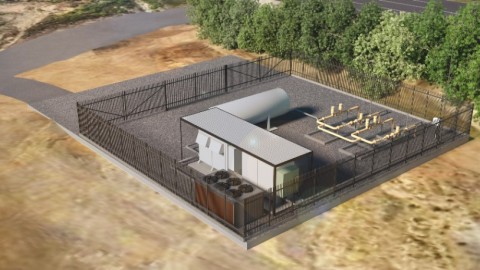by Christopher Allan, Journalist, Energy Magazine
A Virtual Power Plant (VPP) is an emerging technology with the power to unite many Distributed Energy Resources (DERs), like home batteries, under a smart, cloud-based management system. The rise of VPPs has prompted interest from governments, utilities, and consumers alike – so what’s all the fuss about? In this article, we break down the fundamentals of VPPs, explore the live debate surrounding their future role in supporting the grid, as well as offer a consumer perspective on their development.
As Australia’s energy transition unfolds, new technologies and commercial models will help unlock the most value from a growing base of DERs, resources like rooftop solar systems, private battery storage units, and electrical vehicles. Enter the VPP: an emerging technology offering new heights for DERs to participate in the daily management of Australia’s grid.
Getting to know VPPs
The VPP model is quite simple: a centrally managed, cloud-based technology coordinates a large spread of distributed resources – perhaps several hundred household batteries – to meet local and live demands of the grid.
Customers participating in a VPP surrender some or all of the dispatchability of their asset to a central, cloud-based management system, opening up the asset to a variety of grid opportunities including voltage management and contingency reserve power.
Through its decentralised model, the VPP excels at aggregating storage and generation capacity of many different private resources, some of which may have otherwise been managed conservatively and locked ‘behind-the-meter’.
Emerging interest in VPPs reflects how Australia is a global leader when it comes to per capita uptake of DERs: national DER stock already comprises 2.5 million rooftop solar systems with a combined capacity exceeding 10GW, not to mention 73,000 home batteries at a combined capacity of 1.1GW.
And Australia’s close relationship with the DERs isn’t going anywhere: the most conservative scenarios in AEMO’s 2020 Integrated System Plan (ISP) still predicted DER growth of 200 per cent by 2040, with DERs eventually providing between 13 to 22 per cent of underlying National Energy Market (NEM) energy consumption.
Breaking VPPs into commercial viability is an intriguing prospect on the horizon for the energy industry, given the sheer size and promise of Australia’s DER sector.
AEMO’s VPP Demonstrations program
In 2019, AEMO launched a three-year trial of VPPs in Australia – the VPP Demonstrations program – providing “early insights on how to integrate VPPs into market frameworks at scale”.
The $7 million program was delivered in collaboration with commercial partners like AGL, Tesla and Energy Locals, for a total of eight operational VPPs distributed across all mainland states of the NEM.
The scale of the VPP Demonstrations was modest – boasting a total registered capacity of 31MW, comparable to “a small scheduled hybrid solar farm plus battery” and reaching approximately 7,150 VPP customers.
The lure of FCAS markets
Importantly, AEMO’s Demonstrations tested the capacity of VPPs to participate in Frequency Control Ancillary Services (FCAS) markets, an exciting frontier for integrating VPPs into the NEM. In the most fundamental sense, frequency control services play an essential role in stabilising the frequency of the grid over short timescales, preventing network outages and other hazards.
Of the eight FCAS markets in the NEM, the first two are regulation services – raising and lowering grid frequency every four seconds, and smoothening mismatches in supply and demand.
The other six FCAS markets are contingency markets – with capacity that is only called upon when required – and they return the frequency of the grid to normal limits after an event like damage to a transmission line, or a sudden change in weather affecting renewable generation.
The eight operational VPPs in AEMO’s Demonstrations project all entered contingency FCAS markets successfully, thanks to a special regulatory framework for the trial.
For example, the Tesla VPP in South Australia, managed by retailer Energy Locals, was approved by AEMO to operate at 10MW of capacity across all six of the FCAS contingency markets.
However, concerns still exist surrounding the suitability of VPP participation in FCAS markets when compared to assets that have been better studied and are more conventionally dispatchable.
Two common criticisms levelled at VPP participation in FCAS markets are that the operational margins of error for many VPPs are still too high given the longer latency times of many DER assets, and that there is room for growth for VPPs in terms of operational visibility and standardisation.
AEMO’s verdict on FCAS
While the VPP Demonstrations were widely regarded for providing groundbreaking knowledge on the future of VPPs, the special regulatory approach that AEMO adopted during the trial has not been extended for the industry at large, due to mixed responses in the energy sector.
The two major regulatory adjustments made for VPPs to participate in FCAS markets were relaxing the interval of frequency metering to a duration of one second, as well as offering flexibility for metering at the point of inverter or controllable asset, as opposed to at the connection point.
AEMO signalled that neither of these regulatory concessions would be extended beyond the trial, recommending that FCAS participation requires latencies as fast as 200 milliseconds, and metering to be assessed at the connection point level.
In December 2021, AEMO released a Final Determination on the appropriate regulatory conditions for VPPs in the FCAS market, and industry partners were invited to share their perspectives.
A number of energy retailers and technology companies, such as Evergen, shared their disappointment in the final regulatory outcome for FCAS participation, pointing out that regulations, while important, could damage the commercial viability of VPPs in the short-term, as some DER assets would need to be upgraded to meet metering and latency requirements.

AEMO’s recent national trial of Virtual Power Plants empowered over 7,000 customers to subscribe private assets, like home batteries, into a live VPP project.
Ultimately, AEMO justified all of its final rulings, explaining how operational error rates were still a little high when using the trial conditions of the VPP Demonstrations, a concern that is especially pertinent because of the role that FCAS markets play in grid stability.
AEMO also pointed to how the VPP Demonstrations fulfilled its mission statement by offering unprecedented knowledge about industry readiness for the new technology, pointing to key recommendations for cybersecurity and operational visibility priorities for development in the VPP space.
One middle-ground solution raised among the industry submissions in AEMO’s Final Determination was the development of a separate set of regulatory conditions for FCAS participation that applies only to VPPs.
A consumer perspective
Beyond network and regulatory insights, another groundbreaking component in the VPP Demonstrations project was conducting social research into what is and isn’t working from a consumer perspective on VPPs. Matt Armitage, the former Manager of DER Market Integration at AEMO, described key consumer insights achieved by the Demonstrations in a knowledge-sharing webinar held in September.
Mr Armitage explained that most customers were engaged and satisfied with VPP participation, yet emphasised future opportunities to “improve the quality and relevance of communication to consumers to enhance their engagement and retain their engagement”.
“Early adopters are still the ones really driving the uptake of VPPs, although we are getting into slightly broader parts of the market,” Mr Armitage said. “If you are a VPP that’s just starting out, it’s probably useful to target early adopters to attract them into your VPP to begin with, and then to develop a strategy to attract other segments of customers as the market matures –- and as you as a VPP mature.”
The social research, conducted by Customer Service Benchmarking Australia (CSBA), also revealed that while customers are motivated by the savings achieved through subscribing their asset into a VPP scheme, two secondary motivations were the environmental impact of reducing emissions and the community impact of helping stabilise the grid from outages.
“It’s recommended to explore initiatives that broaden appeal to different types of consumers, particularly thinking about those other motivating factors like community benefits or environmental benefits, to attract and retain new customers,” Mr Armitage said.
In terms of managing customer experiences of VPPs over time, it is evident that key values include visibility and choice. “Customers really loved having an app that they could look at every day,” Mr Armitage said.
“The app is a really strong tool to help improve the customer experience, so one of the recommendations is to develop a really strong app experience.” Mr Armitage also explained how energy bill reviews can be used to ensure that customer expectations formed when first subscribing their asset into a VPP are being met, “Something to keep an eye on is customer-switching: how you develop strategies to target customers switching in to your VPP, and keeping an eye on replacements.”
A final consumer recommendation directed at VPP retailers is the appropriate investment in knowledgeable customer service staff. “This is a kind of quite technical and complex part of the industry,” Mr Armitage said.
“Investment in customer service staff – to really have those detailed conversations with customers, to put customer concerns at ease and answer customer questions – is really valuable if you’re a VPP starting out.”
As the VPP market continues to mature, accommodating more and more DER assets and breaking into commercial viability, new conversations will emerge surrounding greater competition and operational visibility among VPP retailers, as well as how customers can be empowered to find the right model for their asset.
The road ahead for VPP projects
The eight VPPs of AEMO’s Demonstrations project, which have been given approval to operate under trial regulatory conditions until June 2023, are as follows:
» Energy Locals – Tesla (SA)
» AGL (SA)
» Simple Energy (SA)
» sonnen (NSW)
» ShineHub (SA)
» Energy Locals – Members Energy (VIC and NSW)
» Hydro Tasmania (QLD)
With AEMO’s national findings fully released, VPP retailers are continuing to gain traction nationally, expanding the technology into new models of commercial viability and a larger role in DER asset management.
In December 2021, Simply Energy announced that they will expand their VPP program out of South Australia and towards the eastern seaboard, as well as open the scheme up to five new battery brands. Ryan Wavish, General Manager at Simply Energy, celebrated the VPP model for making a “significant dent” in the affordability of batteries and other renewable technologies.
In Western Australia, a $35.5 million trial of VPPs is just taking off, with Western Power, Synergy, AEMO and Energy Policy WA working together under an initiative named Project Symphony. With VPP prospects growing nationally, the technological, regulatory and consumer knowledge emerging from AEMO’s Demonstrations should help steer VPP growth in the right direction.
Indeed, the new option for a VPP revenue stream for consumers purchasing their first DER asset should only continue to grow the essential national stock of home batteries, rooftop solar panels and electric vehicles.

















